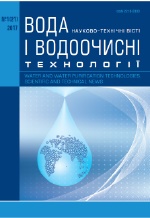Research processes of ion exchange removal phosphates
DOI:
https://doi.org/10.20535/2218-93002112017121427Keywords:
ion exchange, phosphate, sulfate, struvite, ammonium chlorideAbstract
Phosphorus is one of the products of metabolism or degradation of microbial organisms, but its excess leads to accelerated eutrophication. The primary cause of eutrophication – is excessive concentration of nutrients in the water, including phosphates. Among the existing methods of water purification from phosphates ion exchange is the most effective and cheap one. This method is advantageous because of the possibility of processing of the regeneration solutions to produce liquid fertilizers or other useful products. Highly basic anionite AB-17-8 and low basic anionite Dowex Marathon WBA are used as the ion exchange materials. Distilled and tap water close to the characteristics of wastewater of Bortnichy aeration station was used as the medium . It was shown that the exchange capacity of anionite Dowex Marathon WBA for phosphates is low and its use for the removal of phosphates is inappropriate. The highly basic anionite AB-17-8 in chloride and in alkaline form provides effective removal of phosphates from model solutions. The influence of competing compounds of sulfate and chloride in tap water on efficiency of phosphate anions extraction was studied. Regeneration processes were investigated using solutions of sodium or ammonium chlorides in concentration of 10-15%. Method for the removal of interfering compounds of sulfates from regeneration solutions in the form of gypsum is proposed, which will allow re-use of these solutions for the regeneration of the anion exchanger.References
Voronov, YU. V. Water removal and wastewater treatment [Vodootvedenie i ochistka stochnykh vod]. Мoskow, The Association of Construction Universities, 2009, 760 p.
Dolina, L. F. Wastewater treatment from biogenic elements [Ochistka stochnykh vod ot biogennikh elementov]. Monograph. Dnepropetrovsk: Kontinent, 2011, 198 p.
Zeifman, E. A., Lebedeva, Е. А., Tikhanovskaia, G. А. Intensification of wastewater treatment processes from biogenic elements [Intensifikatsiia protsessov ochistki stochnykh vod ot biogennikh elementov]. Vologda, VolSTU, 2003, 144 p.
Dils, R., Leaf, S., Robinson, R. and Sweet, N. Phosphorus in the environment – why should recovery be a polyci issue? Environment Agency. CEEP, 2001, available at: http://www.nhm.ac.uk/researchcuratoin/projects/phosphate-recovery/Norwijkerhout/Sweet0204.doc — Назва з екрана.
Stepova, O. V. Analysis phosphate pollution of surface water Poltava region [Analiz fosfatnoho zabrudnennia poverkhnevykh vodoim Poltavskoi oblasti]. Journal of KhNU of Karazin [Visnyk KhNU im. V.N. Karazina], Kharkiv, 2016, №14, P. 78—82.
Podorvan, N. I., Globa, L. I., Kulikov, N. I. and Gvozdyak, P. I. Removal of phosphorus compounds from waste water. Journal of water Chemistry and Techolology, 2004, №6(26), P. 44—54.
Khentse, M., Armoes, P. and Lia-Kur-Yasen, Y. Sewage treatment [Ochistka stochnykh vod]. Moskow, Mir, 2009, 480 p.
Radovenchik, V. M., Glushko, O. V. and Kolomitsev, D. V. Removal of ammonium ions from wastewater by chemical precipitation [Vydalennia ioniv amonyu iz stichnykh vod khimichnym metodom]. Ecology and resource conservation [Ekologiia i resursosberezhenie], 2004, №5, P. 55—58.
Seminska, O. O., Kucheruk, D. D., Balakina, M. M. and Goncharuk, V. V. The use of reverse osmosis and nanofiltration in wastewater treatment from phosphate [Vykoristannia zvorotnogo osmosu ta nanofiltratsii v ochyshchenni stichnykh vod vid fosfativ]. Reports of the National Academy of Sciences of Ukraine [Dopovidi NAN Ukrainy], 2015, №7, P. 150—156.
Bhuiyan, M. I. H., Mavinic, D. S. and Korch, F. A. Phosphorus recovery from wastewater through struvite formation in fluidized bed reactors: A sustainable approach. Water Science and Technology. 2008, №57, P. 175—181.
Dedkov, YU. M., Konichev, M. A., Kelina, S. YU. Methods of post-treatment of wastewater from phosphates [Metody doochistki stochnykh vod ot fosfatov]. Water supply and sanitary engineering [Vodosnabzhenie i kanalizatsiia]. 2003, №11. P. 25—31.
Gomelya, M. D., Trohymenko, G. G. and Shabliy, T. O. Low-water ion exchangetechnology of extraction of nitrogen compouds from woter. Easter-Europen Journal of Enterprise technologies, 2016, №3(81), P. 18—23.
Trus, I. N., Gomelia, N. D., Shablii, T. A. Separation of chlorides and sulfates during ion-exchange desalination of water [Razdelenie khloridov i sulfatof pri ionoobmennom obezsolivanii vody]. Metallurgical and mining industry [Metalurgicheskaia i gornorudnaia promyshlennost]. 2014, №5, P. 119—122.
Lure, YU. YU. Analytical chemistry of industrial wastewater [Analiticheskaia khimiia promishlennykh stochnykh vod]. Moskow. Chemistry, 1984, 448 p.
Downloads
Published
How to Cite
Issue
Section
License
Copyright (c) 2020 М. Д. Гомеля, A. I. Петриченко, Г. Г. Трохименко, Я. П. Мартинюк

This work is licensed under a Creative Commons Attribution-NonCommercial 4.0 International License.
The ownership of copyright remains with the Authors.
Authors may use their own material in other publications provided that the Journal is acknowledged as the original place of publication and National Technical University of Ukraine “Igor Sikorsky Kyiv Polytechnic Institute” as the Publisher.
Authors are reminded that it is their responsibility to comply with copyright laws. It is essential to ensure that no part of the text or illustrations have appeared or are due to appear in other publications, without prior permission from the copyright holder.
WPT articles are published under Creative Commons licence:
- Authors retain copyright and grant the journal right of first publication with the work simultaneously licensed under CC BY-NC 4.0 that allows others to share the work with an acknowledgement of the work's authorship and initial publication in this journal. The use of the material for commercial purposes is not permitted.
- Authors are able to enter into separate, additional contractual arrangements for the non-exclusive distribution of the journal's published version of the work (e.g., post it to an institutional repository or publish it in a book), with an acknowledgement of its initial publication in this journal.
- Authors are permitted and encouraged to post their work online (e.g., in institutional repositories or on their website) prior to and during the submission process, as it can lead to productive exchanges, as well as earlier and greater citation of published work.

